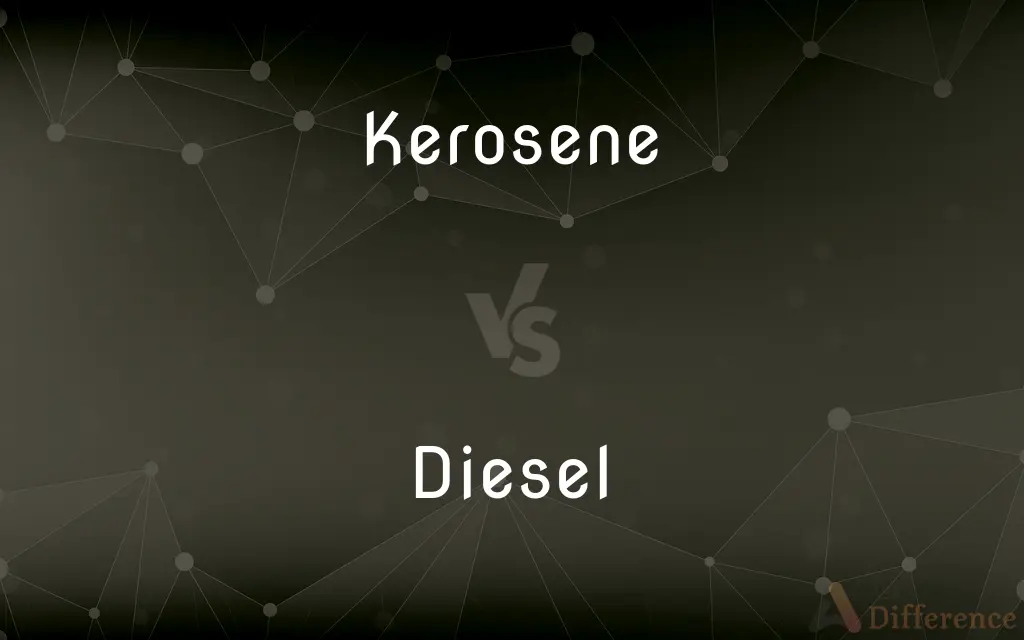Kerosene vs. Diesel — What's the Difference?
By Tayyaba Rehman — Updated on October 27, 2023
Kerosene is a light petroleum distillate used mainly for heating and lighting; diesel is a heavier distillate used as fuel in diesel engines.

Difference Between Kerosene and Diesel
Table of Contents
ADVERTISEMENT
Key Differences
Kerosene and diesel are both products derived from crude oil, but they differ in their properties, uses, and refining processes. Kerosene, a lighter petroleum distillate, is primarily used for heating and lighting. It's often utilized in jet engines as jet fuel and in homes, especially in regions where electricity is scarce. Diesel, in contrast, is a heavier distillate that is predominantly used as a fuel in diesel engines.
The refining process for kerosene and diesel is distinct, rooted in the method of fractional distillation. In this process, crude oil is heated, and different components are separated based on their boiling points. Kerosene boils at a temperature between those of gasoline and diesel, making it mid-range in the spectrum of petroleum products. Diesel has a higher boiling point, placing it after kerosene in the distillation sequence.
Physically, kerosene and diesel have unique characteristics. Kerosene is typically thinner and less viscous than diesel. It also has a lower flash point, which means it can ignite at a lower temperature. Diesel, being more viscous, is oilier and has a distinct strong odor. It's also known for its lubrication properties, beneficial for the internal components of a diesel engine.
In terms of environmental impact, diesel engines often produce more nitrogen oxides and particulates than gasoline engines, but they emit less carbon dioxide. Kerosene, when burned, produces carbon dioxide, water, and heat. Both fuels have environmental considerations, especially regarding carbon emissions and air quality. Still, advancements in refining and engine technologies are constantly working to make both kerosene and diesel cleaner and more efficient.
Overall, while kerosene and diesel both originate from crude oil, they serve different purposes, have different refining processes, and possess distinct physical and environmental properties. Whether for transportation or home heating, both play essential roles in our daily lives.
ADVERTISEMENT
Comparison Chart
Primary Use
Heating, lighting, jet fuel
Fuel for diesel engines
Refining Process
Boils at mid-range in distillation
Boils at a higher point than kerosene
Physical Properties
Thinner, less viscous
Oily, more viscous
Flash Point
Lower flash point
Higher flash point
Environmental Consideration
Produces CO2 when burned
Emits nitrogen oxides, particulates, less CO2
Compare with Definitions
Kerosene
A fuel used primarily for heating and lighting.
They filled the heater with kerosene to warm the room.
Diesel
Fuel used in diesel engines.
The generator runs on diesel fuel.
Kerosene
A component in jet fuel.
Commercial jets often run on a type of kerosene.
Diesel
A heavy distillate from petroleum.
Trucks and buses commonly run on diesel.
Kerosene
A flammable hydrocarbon liquid.
Kerosene lamps provided light in the absence of electricity.
Diesel
A fuel with a distinct strong odor.
The scent of diesel was evident at the fuel station.
Kerosene
A mid-range petroleum product.
Kerosene is positioned between gasoline and diesel in the refining process.
Diesel
Known for its lubricating properties.
Diesel provides good lubrication for engine components.
Kerosene
A liquid with a characteristic odor.
The distinctive smell of kerosene filled the room when the lamp was lit.
Diesel
Efficient in terms of energy density.
Diesel engines are often more fuel-efficient than gasoline engines.
Kerosene
Kerosene is a combustible hydrocarbon liquid which is derived from petroleum. It is widely used as a fuel in aviation as well as households.
Diesel
An internal combustion engine in which heat produced by the compression of air in the cylinder is used to ignite the fuel
A diesel locomotive
Kerosene
A thin oil distilled from petroleum or shale oil, used as a fuel for heating and cooking, in lamps, and as a denaturant for alcohol. Also called coal oil.
Diesel
A diesel engine.
Kerosene
A thin colorless to straw-colored petroleum-based fuel heavier than gasoline/petrol or naptha but lighter than diesel, used primarily as jet fuel but also for heating and lighting in some remote or impoverished areas.
The kerosene lasted all winter, so the furnace kept us always warm.
Diesel
A vehicle powered by a diesel engine.
Kerosene
An oil used for illuminating purposes, formerly obtained from the distillation of mineral wax, bituminous shale, etc., and hence called also coal oil. It is now produced in immense quantities, chiefly by the distillation and purification of petroleum. It consists chiefly of several hydrocarbons of the methane series, having from 10 to 16 carbon atoms in each molecule, and having a higher boiling point (175 - 325° C) than gasoline or the petroleum ethers, and a lower boling point than the oils.
Diesel
Any of various fuels used to power diesel engines, especially one derived from petroleum.
Kerosene
A flammable hydrocarbon oil used as fuel in lamps and heaters
Diesel
To continue running after the ignition has been turned off, as when an open throttle supplies fuel to an engine that is still sufficiently hot to ignite it.
Diesel
To drive a diesel-powered vehicle
We dieseled through the countryside.
Diesel
To refuel a diesel-powered vehicle. Often used with up.
Diesel
A fuel derived from petroleum (or other oils) but heavier than gasoline/petrol. Used to power diesel engines which burn this fuel using the heat produced when air is compressed.
Diesel
(countable) A vehicle powered by a diesel engine.
Diesel
A rider who has an even energy output, without bursts of speed.
Diesel
Snakebite and black (a drink).
Diesel
(slang) A particular cannabis hybrid.
Diesel
To ignite a substance by using the heat generated by compression.
Diesel
(automotive) For a spark-ignition internal combustion engine to continue running after the electrical current to the spark plugs has been turned off. This occurs when there's enough heat in the combustion chamber to ignite the air and fuel mixture without a spark, the same way that heat and pressure cause ignition in a diesel engine.
Diesel
A type of internal-combustion engine in which the air drawn in by the suction stroke is so highly compressed that the heat generated ignites the fuel (usually a heavy oil), the fuel being automatically sprayed into the cylinder under pressure. The Diesel engine has a very high thermal efficiency.
Diesel
German engineer (born in France) who invented the diesel engine (1858-1913)
Diesel
An internal-combustion engine that burns heavy oil
Common Curiosities
Is kerosene lighter than diesel?
Yes, kerosene is thinner and less viscous than diesel.
Is kerosene a type of gasoline?
No, kerosene is a separate distillate from crude oil, positioned between gasoline and diesel in the refining process.
What engines use diesel?
Diesel is used as fuel in diesel engines, commonly found in trucks, buses, and some cars.
Can you mix kerosene and diesel?
While it's possible, it's not recommended without understanding the engine's specifications and potential risks.
Why is diesel more viscous?
Diesel is a heavier petroleum product, making it oilier and more viscous than kerosene.
Why do diesel engines emit black smoke?
Black smoke from diesel engines can be due to incomplete combustion or poor-quality fuel.
Is kerosene safe for indoor heating?
While kerosene heaters can be used indoors, they should be used with caution and in well-ventilated areas to avoid harmful fumes.
What is the primary use of kerosene?
Kerosene is primarily used for heating, lighting, and as jet fuel.
Can kerosene be used in cars?
Typically, cars are not designed to run on kerosene, and using it can damage the engine.
Are diesel engines more fuel-efficient?
Diesel engines often have a higher energy density, making them more fuel-efficient than gasoline engines.
Share Your Discovery

Previous Comparison
Refurbish vs. Refurnish
Next Comparison
Flavoured vs. FlavoredAuthor Spotlight
Written by
Tayyaba RehmanTayyaba Rehman is a distinguished writer, currently serving as a primary contributor to askdifference.com. As a researcher in semantics and etymology, Tayyaba's passion for the complexity of languages and their distinctions has found a perfect home on the platform. Tayyaba delves into the intricacies of language, distinguishing between commonly confused words and phrases, thereby providing clarity for readers worldwide.














































